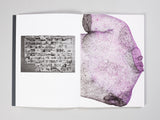How to Move a Mountain is Caleb Stein’s photographic essay of the Carrara marble quarry, a series of intimate portraits of robotic arms and raw marble that offer nuance to today’s debate around artistic authorship and AI and computer-augmented art.
Sent on a commission for Smithsonian Magazine, Caleb Stein traveled to northern Italy to photograph Robotor, a company based in the Carrara quarries that utilizes digital schematics and robotic technology to translate marble into sculpture. The quarry has been mined for millenia, its marble sculpted by generations upon generations of artists and, now, with the introduction of new advancements in technology to the sculptural process, conceptions of artistic authorship come into question.
Photographed in black and white, Stein’s portraits of this site lend an intimate eye to the process. As robotic arms carve topographic maps into the surfaces of the stone, water drips down the steel machinery, the lines mimicking the striations of gray found in the raw marble. This exploration of texture and light reveal the drama unfolding in this quarry–a place where artistic visions find their form, whether assisted by human hand or robotic arm.
Details of the digital schematics that instruct robots to sculpt marble are printed on sheets of tracing paper throughout the book. These spreads both juxtapose and connect Stein’s photographs with the process his images investigate.
The artist book is accompanied by an essay by David Campany, which details the history between photography and sculpture and Stein’s place within this lineage.
Sent on a commission for Smithsonian Magazine, Caleb Stein traveled to northern Italy to photograph Robotor, a company based in the Carrara quarries that utilizes digital schematics and robotic technology to translate marble into sculpture. The quarry has been mined for millenia, its marble sculpted by generations upon generations of artists and, now, with the introduction of new advancements in technology to the sculptural process, conceptions of artistic authorship come into question.
Photographed in black and white, Stein’s portraits of this site lend an intimate eye to the process. As robotic arms carve topographic maps into the surfaces of the stone, water drips down the steel machinery, the lines mimicking the striations of gray found in the raw marble. This exploration of texture and light reveal the drama unfolding in this quarry–a place where artistic visions find their form, whether assisted by human hand or robotic arm.
Details of the digital schematics that instruct robots to sculpt marble are printed on sheets of tracing paper throughout the book. These spreads both juxtapose and connect Stein’s photographs with the process his images investigate.
The artist book is accompanied by an essay by David Campany, which details the history between photography and sculpture and Stein’s place within this lineage.
















